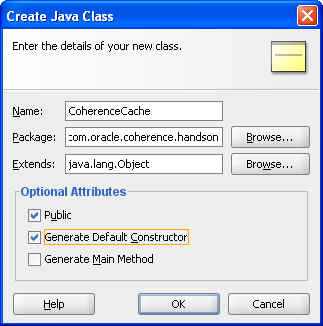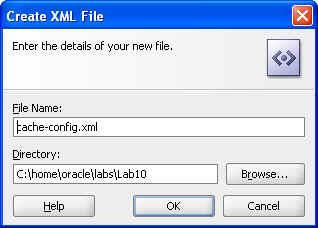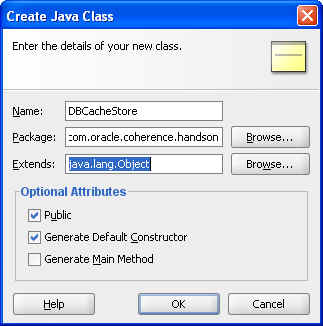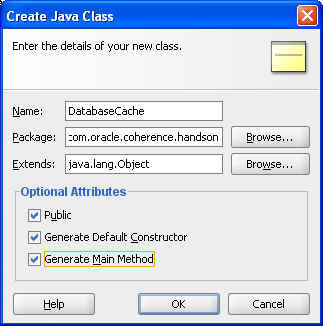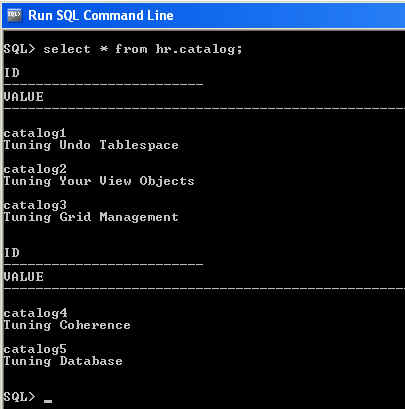8 Interacting with the Cache and the Database
In this chapter, you create and configure an Oracle Coherence cache in Oracle JDeveloper using all the concepts presented in this tutorial.
8.1 Introduction
A Coherence cache is a collection of data objects that serves as an intermediary between the database and the client applications. Database data may be loaded into a cache and made available to different applications. Thus, Coherence caches reduce load on the database and provide faster access to database data.
Coherence caches provide higher availability through database isolation and data replication. Modifications made to a cache may be synchronized with the database whenever the database is available. Even if the database or an application server node is not available, database updates are still reliable due to the lazy load and lazy write mechanism used by a Coherence cache and due to the failover and fail back provided by Oracle Coherence.
Coherence caches provide distributed processing not only across a cluster of application server nodes but also across the data objects in the cache, because data modification operations may be performed on the data objects.
Oracle Coherence also provides event-based processing. The state of data objects in a cache may be monitored and actions invoked on other processes such as the start of a business process execution language (BPEL) process.
Oracle Coherence supports different types of caches.
-
Replicated caches—In a replicated cache, data is replicated to each of the application server nodes in the cluster. This is suitable if faster read access is required but not suitable for writes, because data has to be written to each of the nodes.
-
Distributed (or "partitioned") caches—In a distributed cache, data is distributed (load-balanced) across different nodes. Failover is implemented in a distributed cache using backups, which are also distributed across the cluster nodes.
Oracle Coherence is implemented by using services such as the cluster service, the distributed cache service, and the replicated cache service. Whichever type of cache is used, an application uses the same API to access and store data.
The cache configuration deployment descriptor is used to configure a cache. The root element of the cache configuration file is cache-config. Cache names and name patterns are mapped to cache types in the caching-scheme-mapping element using the subelement cache-mapping. Cache types are defined in the caching-schemes element. Some of the commonly used cache types are described in Table 8-1.
Table 8-1 Descriptions of Cache Types
| Cache Type | Description |
|---|---|
|
distributed scheme |
Defines a distributed cache in which data is stored across a cluster of nodes |
|
replicated scheme |
Defines a cache in which cache entries are replicated across all the cluster nodes |
|
read-write-backing-map scheme |
Defines a map, which provides a cache of a persistent store such as a relational database |
|
external scheme |
Defines an external cache such as a disk |
|
class scheme |
Defines a custom cache implementation, which is required to implement the java.util.Map interface |
8.2 Creating and Configuring a Coherence Cache with Oracle JDeveloper
This exercise pulls together all of the concepts presented in this tutorial. In this exercise you will
-
Create a Java class that creates a
NamedCacheand can put and get cache entries. -
Create a cache configuration file to define the mapping for cache names, cache types, and naming patterns
-
Create a Java class that creates a connection to the Oracle database and can retrieve and store table data.
-
Create a database cache. This class will add cache entries, query the database cache, and retrieve entries.
To create and configure a Coherence cache:
-
Create a project and an application in Oracle JDeveloper.
-
Create a project called
Lab10in Oracle JDeveloper. -
Create a Java class,
CoherenceCache, in the project.The Java class will be used to create a Coherence cache.
-
Create an XML document,
cache-config.xml, as the cache configuration deployment descriptor.To add the XML document, right-click Lab10 > New. In the New Gallery window, select XML under General categories. Select XML Document and click OK. Change the File Name to
cache-config.xml. Note: You will update the contents ofcache-config.xmlin Step 4 of this exercise.
-
-
Add the Coherence JAR file
coherence.jarto the project libraries. Also add the Oracle JDBC library, which is required for database access to the project libraries.The Coherence JAR file is in the
oracle\product\coherence\libdirectory (the Oracle Coherence installation). It should already be present in the Libraries and Classpath dialog box. To add the Oracle JDBC library, click Tools > Project Properties > Add Library > Oracle JDBC.Figure 8-4 Adding the Oracle JDBC Libraries to the Classpath
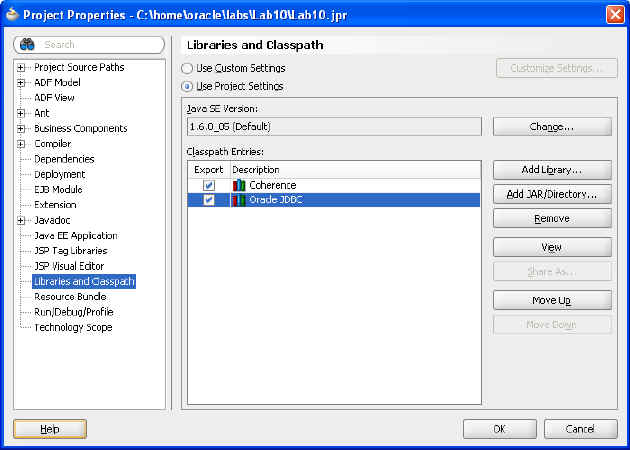
Description of "Figure 8-4 Adding the Oracle JDBC Libraries to the Classpath"
-
Modify the Run configuration for the application to add the cache configuration file as a run-time Java option.
-
Select the project node and select Tools > Project Properties. In the Project Properties window, select Run/Debug/Profile. The Default configuration is selected by default. Click Edit for the Default configuration.
-
In the Edit Run Configuration window, select Launch Settings. In the Java Options field, specify the cache configuration file (
cache-config.xml) with-Dtangosol.coherence.cacheconfig=[path-to-cache-config-file]/cache-config.xml.For example, for the Oracle Coherence application that you created, specify the following (your path to
cache-config.xmlmay vary) in the Java Options field and click OK.-Dtangosol.coherence.cacheconfig=/home/oracle/labs/Lab10/cache-config.xml
Figure 8-5 Setting the Cache Configuration File for Runtime Options
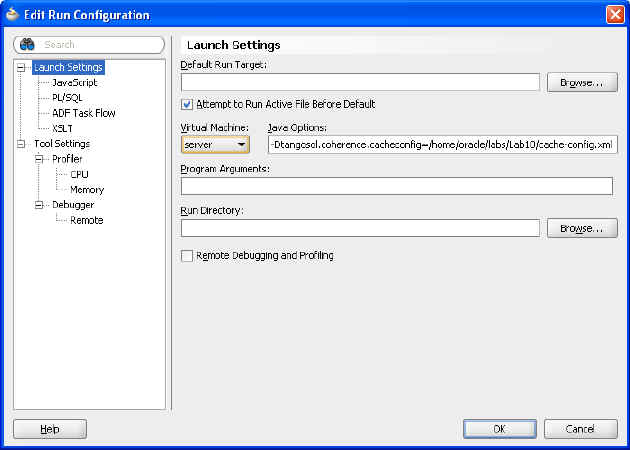
Description of "Figure 8-5 Setting the Cache Configuration File for Runtime Options"
Click OK in the Run/Debug/Profile window. The cache configuration file will be added as a run-time Java option to the Coherence Java application.
-
-
In the cache configuration file:
-
Define mapping for cache names and naming patterns with the
cache-mappingelements in thecaching-scheme-mappingelement. -
Specify the default mapping to cache type
default-replicatedand map cache nameVirtualCacheto cache typedefault-distributed. -
Define the distributed caching scheme with the
distributed-schemeelement using theDistributedCacheservice.
The cache configuration file is listed in Example 8-1. Copy the contents of this example to the
cache-config.xmlfile in Oracle JDeveloper.Example 8-1 Cache Configuration File
<?xml version="1.0"?> <!DOCTYPE cache-config SYSTEM "cache-config.dtd"> <cache-config> <caching-scheme-mapping> <cache-mapping> <cache-name>VirtualCache</cache-name> <scheme-name>default-distributed</scheme-name> </cache-mapping> </caching-scheme-mapping> <caching-schemes> <!-- Default Distributed caching scheme. --> <distributed-scheme> <scheme-name>default-distributed</scheme-name> <service-name>DistributedCache</service-name> <backing-map-scheme> <class-scheme> <scheme-ref>default-backing-map</scheme-ref> </class-scheme> </backing-map-scheme> </distributed-scheme> <class-scheme> <scheme-name>default-backing-map</scheme-name> <class-name>com.tangosol.util.SafeHashMap</class-name> </class-scheme> </caching-schemes> </cache-config> -
-
Create the cache application.
-
Create a cache in the
CoherenceCacheJava class. Import theCacheFactoryclass and theNamedCacheinterface.import com.tangosol.net.CacheFactory; import com.tangosol.net.NamedCache;
-
An instance of a cache is created from the
CacheFactoryclass. Create aNamedCacheusing thegetCache()method of theCacheFactoryclass. Use the cache nameVirtualCache, which is mapped to a distributed caching scheme.NamedCache cache = CacheFactory.getCache ( "VirtualCache");
-
A
NamedCacheis ajava.util.Mapthat holds resources that are shared across nodes in a cluster. Add a cache entry using theput()method.cache.put (key, "Hello Cache");
-
A cache entry can be retrieved using the
get()method.System.out.println((String)cache.get("hello"));Example 8-2 illustrates a possible solution. You can copy the code to the
CoherenceCacheapplication in Oracle JDeveloper.Example 8-2 Implementation of a Coherence Cache
package com.oracle.coherence.handson; import com.tangosol.net.CacheFactory; import com.tangosol.net.NamedCache; public class CoherenceCache { NamedCache cache; public CoherenceCache() { } public void putCache(){ cache = CacheFactory.getCache ( "VirtualCache"); String key = "hello"; cache.put (key, "Hello Cache"); } public void retrieveCache(){ System.out.println((String)cache.get("hello")); } public static void main (String [] args) { CoherenceCache cache = new CoherenceCache(); cache.putCache(); cache.retrieveCache(); } } -
Stop any running cache servers. Start the JPA cache server (
jpa-cache-server.cmd) that you created in Chapter 7, "Using JPA with Coherence". -
Right-click the Oracle Coherence application
CoherenceCache.javaand click Run.The Oracle Coherence application runs and the output is displayed in the Log window. The output shows that the operational configuration is loaded from
tangosol-coherence.xml, the cache configuration is loaded fromcache-config.xml, a new cluster is created, and theDistributedCacheservice joins the cluster. The operational deployment descriptortangosol-coherence.xmlspecifies the operational and run-time settings used by Coherence for its clustering, communication, and data management services.Figure 8-6 Output from the CoherenceCache Program
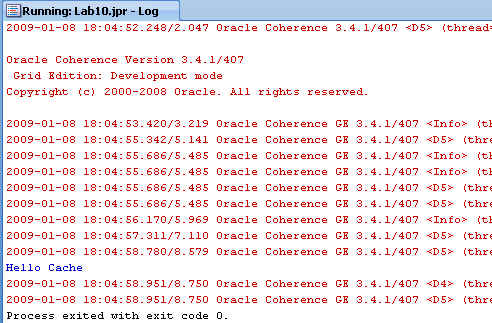
Description of "Figure 8-6 Output from the CoherenceCache Program"
If you see any exceptions, such as the following, can you determine the reason?
"java.lang.IllegalArgumentException: No scheme for cache: "cachename"
-
-
Create an Oracle database cache.
In this section, you create an Oracle database cache, which is a cache backed by the Oracle database.
-
Invoke SQL*Plus.
Navigate to Start > All Programs > Oracle Database 10g Express Edition > Run SQL Command Line.
-
Connect as
hruser withhras the password.connect hr/hr;
-
Create an Oracle Database table.
Open a text editor and copy the following SQL code. Save the file as
dbscript.sqlin the/home/oracle/labs/folder. -
Run the SQL script.
Figure 8-7 illustrates Steps 6b, 6c, and 6d.
Figure 8-7 Creating a Table in the Oracle Database
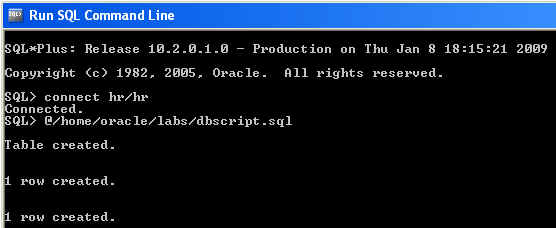
Description of "Figure 8-7 Creating a Table in the Oracle Database"
-
-
Create a custom
CacheStore.-
Create a Java class
DBCacheStorein Oracle JDeveloper. -
Create the code to connect to the database and get table data.
Example 8-4 illustrates a possible solution. Copy the code to the
DBCacheStoreapplication in Oracle JDeveloper. TheDBCacheStoreapplication uses Java Database Connectivity (JDBC) to access Oracle Database, but another mechanism, such as Hibernate or Java Data Objects (JDO), may also be used.Example 8-4 Database CacheStore Implementation
package com.oracle.coherence.handson; import com.tangosol.net.cache.CacheStore;import com.tangosol.util.Base; import java.sql.DriverManager; import java.sql.Connection; import java.sql.PreparedStatement; import java.sql.ResultSet; import java.sql.SQLException; import java.util.Collection; import java.util.Iterator; import java.util.LinkedList; import java.util.List; import java.util.Map; public class DBCacheStore extends Base implements CacheStore { protected Connection m_con; protected String m_sTableName; private static final String DB_DRIVER = "oracle.jdbc.OracleDriver"; private static final String DB_URL = "jdbc:oracle:thin:@localhost:1521:XE"; private static final String DB_USERNAME = "hr"; private static final String DB_PASSWORD = "hr"; public DBCacheStore(String sTableName) { m_sTableName = sTableName; configureConnection(); } protected void configureConnection() { try { Class.forName("oracle.jdbc.OracleDriver"); m_con = DriverManager.getConnection(DB_URL, DB_USERNAME, DB_PASSWORD); m_con.setAutoCommit(true); } catch (Exception e) { throw ensureRuntimeException(e, "Connection failed"); } } public String getTableName() { return m_sTableName; } public Connection getConnection() { return m_con; } public Object load(Object oKey) { Object oValue = null; Connection con = getConnection(); String sSQL = "SELECT id, value FROM " + getTableName() + " WHERE id = ?"; try { PreparedStatement stmt = con.prepareStatement(sSQL); stmt.setString(1, String.valueOf(oKey)); ResultSet rslt = stmt.executeQuery(); if (rslt.next()) { oValue = rslt.getString(2); if (rslt.next()) { throw new SQLException("Not a unique key: " + oKey); } } stmt.close(); } catch (SQLException e) { throw ensureRuntimeException(e, "Load failed: key=" + oKey); } return oValue; } public void store(Object oKey, Object oValue) { Connection con = getConnection(); String sTable = getTableName(); String sSQL; if (load(oKey) != null) { sSQL = "UPDATE " + sTable + " SET value = ? where id = ?"; } else { sSQL = "INSERT INTO " + sTable + " (value, id) VALUES (?,?)"; } try { PreparedStatement stmt = con.prepareStatement(sSQL); int i = 0; stmt.setString(++i, String.valueOf(oValue)); stmt.setString(++i, String.valueOf(oKey)); stmt.executeUpdate(); stmt.close(); } catch (SQLException e) { throw ensureRuntimeException(e, "Store failed: key=" + oKey); } } public void erase(Object oKey) { Connection con = getConnection(); String sSQL = "DELETE FROM " + getTableName() + " WHERE id=?"; try { PreparedStatement stmt = con.prepareStatement(sSQL); stmt.setString(1, String.valueOf(oKey)); stmt.executeUpdate(); stmt.close(); } catch (SQLException e) { throw ensureRuntimeException(e, "Erase failed: key=" + oKey); } } public void eraseAll(Collection colKeys) { throw new UnsupportedOperationException(); } public Map loadAll(Collection colKeys) { throw new UnsupportedOperationException(); } public void storeAll(Map mapEntries) { throw new UnsupportedOperationException(); } public Iterator keys() { Connection con = getConnection(); String sSQL = "SELECT id FROM " + getTableName(); List list = new LinkedList(); try { PreparedStatement stmt = con.prepareStatement(sSQL); ResultSet rslt = stmt.executeQuery(); while (rslt.next()) { Object oKey = rslt.getString(1); list.add(oKey); } stmt.close(); } catch (SQLException e) { throw ensureRuntimeException(e, "Iterator failed"); } return list.iterator(); } } -
Modify the cache configuration file that you created earlier (
cache-config.xml) for the database cache.To connect a cache to a back-end database, a cache configuration file (
cache-config.xml) elementcachestore-schemeis required. Thecachestore-schemeelement must be configured with a custom class that implements either thecom.tangosol.net.cache.CacheLoaderorcom.tangosol.net.cache.CacheStoreinterface.Copy the cache configuration file for the database cache in Example 8-5 and Replace the existing code in the
cache-config.xmlfile in Oracle JDeveloper.
Example 8-5 Database Cache Configuration File
<?xml version="1.0" encoding="UTF-8" ?><cache-config> <caching-scheme-mapping> <!-- Caches with names that start with 'DBBacked' will be created as distributed-db-backed. --> <cache-mapping> <cache-name>DBBacked*</cache-name> <scheme-name>distributed-db-backed</scheme-name> </cache-mapping> </caching-scheme-mapping> <caching-schemes> <!-- DB Backed Distributed caching scheme. --> <distributed-scheme> <scheme-name>distributed-db-backed</scheme-name> <service-name>DistributedCache</service-name> <backing-map-scheme> <read-write-backing-map-scheme> <internal-cache-scheme> <class-scheme> <class-name>com.tangosol.util.ObservableHashMap</class-name> </class-scheme> </internal-cache-scheme> <cachestore-scheme> <class-scheme> <class-name>com.oracle.coherence.handson.DBCacheStore</class-name> <init-params> <init-param> <param-type>java.lang.String</param-type> <param-value>CATALOG</param-value> </init-param> </init-params> </class-scheme> </cachestore-scheme> <read-only>false</read-only> <!-- To make this a write-through cache just change the value below to 0 (zero) --> <write-delay-seconds>0</write-delay-seconds> </read-write-backing-map-scheme> </backing-map-scheme> <listener/> <autostart>true</autostart> </distributed-scheme> </caching-schemes></cache-config>
In the cache configuration file, you have taken care of the following:
—Define a cache name pattern
DBBacked*, which is mapped to a distributed caching schemedistributed-db-backed.—Specify the
CacheStorescheme in the distributed scheme using the classcoherence.DBCacheStore, which implements theCacheStoreinterface.—An
initparameter for the database table that is at the back end of the cache is specified for theDBCacheStoreclass. The table name is specified in theinit-paramelement. TheDBCacheStoreclass performs database operations such as reading and writing cache entries.—Coherence supports read/write caching of a data source for which the
read-write-backing-mapscheme is used. Theread-write-backing-mapscheme defines a backing map, which provides a size-limited cache of a persistent store. Here, you use the Write-Through mechanism. Oracle Coherence supports the types of read/write caching described in Table 8-2:Table 8-2 Types of Read-Write Caching Supported by Coherence
Types of Read-Write Caching Action Read-Through
A cache entry is read into a cache from the database when required and made available to an application.
Write-Through
Updates to cache entries are synchronized with the database without delay.
Refresh-Ahead
Cache entries are refreshed periodically.
Write-Behind
Updates to cache entries are asynchronously written to a database after a delay specified in the write-delay-seconds element in the cache configuration file.
-
-
Create a Java class
DatabaseCachefor the database cache in Oracle JDeveloper. The class must contains amainmethod.In the class file, add code to add a cache entry, query a database cache, and retrieve a cache entry. Add the following methods:
createCache(),addEntry(),retrieveEntry(),eraseEntry(), andqueryCache(). You can copy the code that is listed in Example 8-6.Example 8-6 Implementation for the Database Cache Class File
package com.oracle.coherence.handson; import com.tangosol.net.CacheFactory; import com.tangosol.net.NamedCache; import com.tangosol.net.cache.ContinuousQueryCache; import com.tangosol.util.Filter; import com.tangosol.util.extractor.IdentityExtractor; import com.tangosol.util.filter.LikeFilter; import java.util.HashSet; import java.util.Iterator; import java.util.Map; import java.util.Set; public class DatabaseCache { NamedCache cache; public DatabaseCache() { } public void createCache() { cache = CacheFactory.getCache("DBBackedCache"); //cache.put(new String("catalog3"), new String("Evolving Grid Management")); // System.out.println((String) cache.get( "catalog3")); } public void addEntry() { cache.put(new String("catalog3"), new String("Tuning Grid Management")); cache.put(new String("catalog4"), new String("Tuning Coherence")); cache.put(new String("catalog5"), new String("Tuning Database")); //System.out.println((String) cache.get( "catalog3")); } public void retrieveEntry() { System.out.println((String) cache.get( "catalog3")); } public void eraseEntry() { cache.remove(new String("catalog3")); } public void queryCache() { Filter filter = new LikeFilter(IdentityExtractor.INSTANCE, "Tuning%", '\\', true); HashSet hashSet=new HashSet(); hashSet.add(new String("catalog3")); hashSet.add(new String("catalog4")); hashSet.add(new String("catalog5")); Map map=cache.getAll(hashSet); //ContinuousQueryCache queryCache = new ContinuousQueryCache(cache, filter); //Set results = queryCache.entrySet(filter); Set results = cache.entrySet(filter); /* Set results = cache.entrySet(filter);*/ // if(results.isEmpty()) // System.out.println("Result Set Empty"); for (Iterator i = results.iterator(); i.hasNext();) { Map.Entry e = (Map.Entry) i.next(); System.out.println("Catalog ID: "+e.getKey() + ", Title: "+e.getValue()); } } public static void main(String[] args) { DatabaseCache databaseCache = new DatabaseCache(); databaseCache.createCache(); databaseCache.addEntry(); //databaseCache.retrieveEntry(); //databaseCache.eraseEntry(); databaseCache.queryCache(); } }Note the following features of the code:
-
A
NamedCacheobject is created using thegetCache()method of theCacheFactoryclass in theaddEntry()method.NamedCache cache = CacheFactory.getCache("DBBackedCache"); -
The
DBBackedCachematches the cache patternDBBacked*and is, therefore, mapped to a distributed caching schemedistributed-db-backedin thecache-config.xmlfile. Add a cache entry using theput()method of theNamedCacheobject.cache.put(new String("catalog3"), new String("Tuning Grid Management")); -
Because the Write-Through mechanism is used, the new cache entry also gets synchronized with the database; a new row is added to the
CATALOGtable. Comment out all the methods except thecreateCache()andaddEntry()methods. -
When the
put()method is invoked, thestore()method, which maps the new cache entry to the database tableCATALOGusing JDBC, gets invoked in theDBCacheStoreclass. The output from the Oracle Coherence application is displayed in the Log window and a new cache entry is added. The output shows that the operational configuration deployment descriptor is loaded, the cache configuration is loaded, a new cluster is created, and theDistributedCacheservice has joined the cluster. -
The new cache entry may be removed with the
remove()method of theNamedCacheobject.cache.remove(new String("catalog3")); -
Bulk uploading of cache entries is performed using the
putAll()method. -
A cache entry is retrieved using the
get()method of theNamedCacheobject. For example, retrieving the cache entry for IDcatalog1:System.out.println((String) cache.get("catalog1")); -
When the
get()method is invoked, theload()method, which retrieves database table data using JDBC, gets invoked in theDBCacheStoreclass. -
Bulk retrieval is performed using the
getAll()method of theNamedCacheobject. -
Oracle Coherence supports searching for cache entries based on a search criteria using filters. Coherence filters are available in the
com.tangosol.util.filterpackage. In Oracle Coherence Enterprise Edition and Grid Edition, indexes may be added to the Coherence cache to improve performance. You query the database cache using aLikeFilterfilter, which matches cache entries with a specified pattern. To query a database cache, the cache entries are required to be created before querying; the cache entries must be retrieved into the cache using theget()orgetAll()method before a query using a filter may be performed. Therefore, you can retrieve database data and create a collection of cache entries using thegetAll()method.HashSet hashSet=new HashSet(); hashSet.add(new String("catalog1")); hashSet.add(new String("catalog2")); hashSet.add(new String("catalog3")); Map map=cache.getAll(hashSet); -
A
LikeFilterfilter is created to search for cache entries starting withTuning.Filter filter = new LikeFilter(IdentityExtractor.INSTANCE, "Tuning%", '\\', true);
-
The database cache is queried using the
entrySet()method with theLikeFilterfilter.Set results = cache.entrySet(filter);
-
Iterate over the results of the query to output the cache entries retrieved.
for (Iterator i = results.iterator(); i.hasNext();) { Map.Entry e = (Map.Entry) i.next(); System.out.println("Catalog ID: "+e.getKey() + ", Title: "+e.getValue()); } -
Oracle Coherence supports continuous query using the
com.tangosol.net.cache.ContinuousQueryCacheclass. A continuous query is a query that is kept up-to-date using a continuous query cache. In aContinuousQueryCache, the results of a query are updated using event listeners on events that could change the results of the query. Create aContinuousQueryCacheobject using theNamedCacheobject and theLikeFilterobject.ContinuousQueryCache queryCache = new ContinuousQueryCache(cache, filter );
-
A result set is created using the
entrySet()method.Set results = queryCache.entrySet(filter);
-
-
Stop any running cache servers. Start the JPA cache server (
jpa-cache-server.cmd) that you created in Chapter 7, "Using JPA with Coherence". -
Right-click the
DatabaseCacheapplication in Oracle JDeveloper and select Run. Figure 8-10 illustrates the expected results.Figure 8-10 Results from Running the DatabaseCache Application

Description of "Figure 8-10 Results from Running the DatabaseCache Application"
If you receive any exceptions, such as the following:
java.lang.IllegalArgumentException: No scheme for cache: "cachename,
You may be able to remove them by editing the
cache-config.xmlfile and replacingDBBacked*in the<cache-name>element with*. Save the file. Re-run theDatabaseCacheapplication in Oracle JDeveloper. You should not see any exceptions now. -
Note that because you are using a Write-Through cache, the database table also gets updated. From the SQL prompt, enter the following code:
select * from hr.catalog;
Figure 8-11 illustrates the results.

